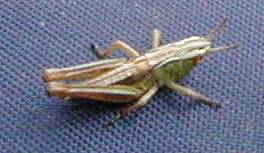
We had hoped that Michael Thompson would lead this trip, but sadly he was ill and unable to attend, so Tom Denney stood in at short notice (with help from Gill and Nan on the plant front). 8 members braved a cold wind (and a very heavy shower as we arrived at the car park) to explore this YWT reserve which we last visited in 1999. It is interesting to compare the two trips. There is considerable overlap between the species recorded as you would expect, but there are also some differences. We did not find as many plants, partly because considerable areas of the birch/alder carr was underwater after the recent heavy rain, and partly I suspect because things were late and so less easy to spot. There were very few insects about, although we did spot this little grasshopper (about ½" long), and a few red damselflies and dragonflies at lunchtime.
Skipwith Common is a YWT nature reserve which was a WWII airfield. The natural soil is peaty, developed on glacial deposits overlying Oxford Clay. The runways were laid on limestone gravel, so there is a wide range of soil types giving a rich patchwork of micro-habitats, especially as parts of the runways have been dug out to form wet areas. The water in the various ponds on the reserve is neutral thanks to the runoff from the limy gravel, and two sorts of newts live here as well as frogs, toads, grass snakes, adders, lizards and slow-worms.
Probably the highlight of the day, certainly from a birding point of view, occurred right at the beginning as we were getting ready to explore the reserve. Tom: “What’s that big raptor?” It was a red kite, and as it flew closer and circled a couple of times before gliding over the birch woods we had a wonderful view of this magnificent bird, showing its characteristic outline with the clearly forked tail very obvious. The second “star turn” was a tree pipit performing its parachute display and song. We then had the chance to compare the songs of garden warbler and blackcap as both were singing. It was wonderful to have an expert on hand to teach us about these birds (thanks Tom).
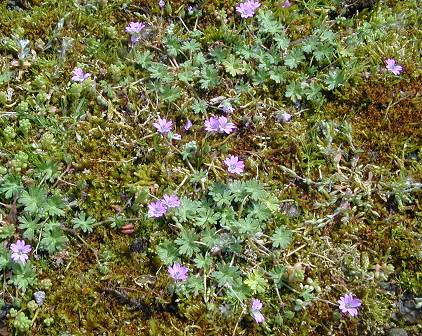 Several plants on the runway surface were dwarfed, hugging the ground. One of these was dovesfoot cranesbill (Geranium molle), seen in close-up on the right.. |
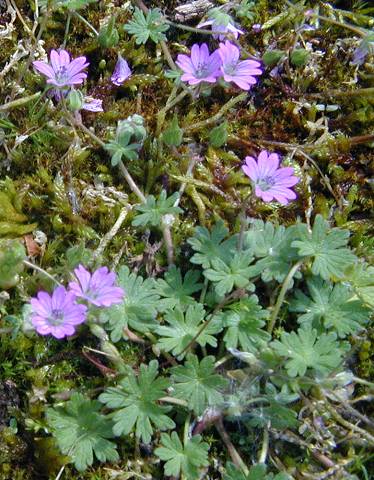 |
At lunch I spotted these lichen cups (the fruiting bodies, about a third of an inch across) growing on a log. A Cladonia species, probably Cladonia fimbriata (thanks, Stuart and Carl). Detail right.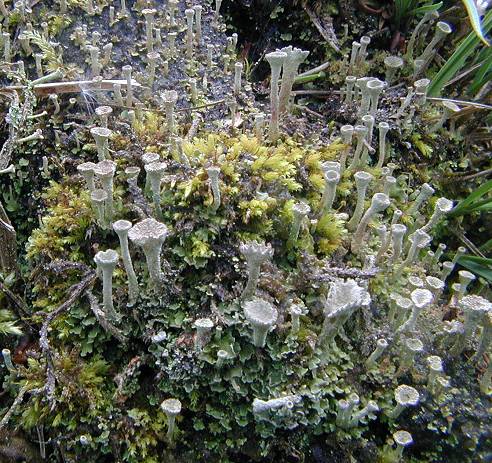 |
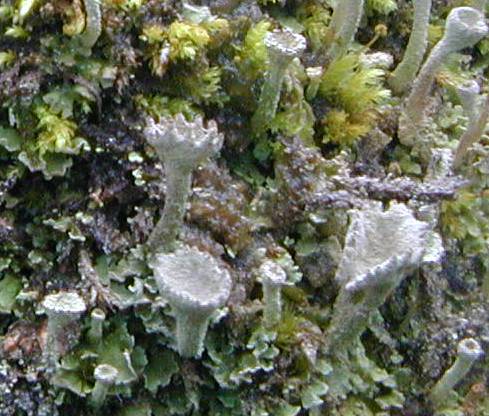 |
We did not see any snakes, but one member was lucky enough to spot a lizard, and I saw one tadpole in a pond and a small frog (probably one of last year’s, it was about an inch and a half long) in a ditch.
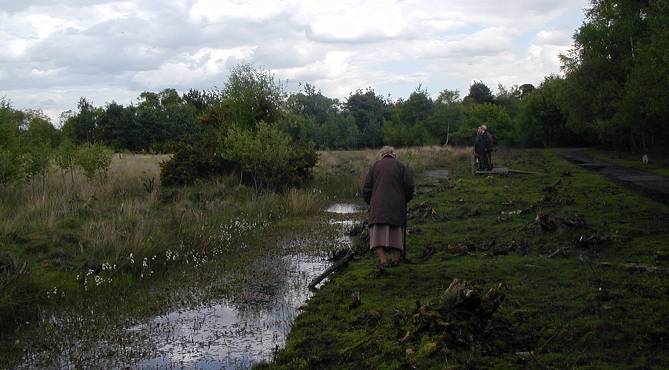
One of the ditches (where the frog was seen) – note the bog-cotton to the left.
Red kite, kestrel, tree pipit, garden warbler, blackcap, willow warbler, chiffchaff , robin, wren, house martin, swift, jay, mistle thrush, geat spotted woodpecker, long-tailed tit, skylark, reed bunting, cuckoo, black-headed gull, crow, pied wagtail, bullfinch and whitethroat (the last three back at the car park),
| Botanical name | English name |
| Alisma plantago-aquatica | Water plantain |
| Alnus glutinosa | Alder |
| Amsinckia intermedia | Amsinckia |
| Anthriscus sylvestris | Cow parsley |
| Aphanes arvensis | Parsley piert |
| Arenaria serpyllifolia | Thyme leaved sandwort |
| Bellis perennis | Daisy |
| Betula pendula | Birch, silver |
| Betula pubescens | Birch, downy |
| Callitriche agg. | Starwort |
| Calluna vulgaris | Heather or Ling |
| Cardamine pratensis | Cuckoo flower or Milkmaid |
| Carex nigra | Common sedge |
| Carex panicea | Carnation sedge |
| Cerastium fontanum | Mouse ear, common |
| Cirsium palustre | Thistle, marsh |
| Ceratocapnos claviculata | Corydalis, climbing |
| Crataegus monogyna | Hawthorn |
| Digitalis purpurea | Foxglove |
| Hyacinthoides non-scripta | Bluebell |
| Equisetum palustre | Marsh Horsetail |
| Erica tetralix | Cross leaved heath |
| Eriophorum angustifolium | Cottongrass, common |
| Erodium cicutarium | Storksbill |
| Erophila verna | Spring whitlowgrass |
| Fragaria vesca | Strawberry, wild |
| Galium aparine | Cleavers |
| Geranium molle | Cranesbill, dovesfoot |
| Hydrocotyle vulgaris | Marsh pennywort |
| Juncus effusus | Soft Rush |
| Lamium album | Deadnettle, white |
| Lonicera periclymenum | Honeysuckle |
| Luzula multiflora | Woodrush, heath |
| Myosotis arvensis | Forgetmenot, field |
| Myosotis discolor | Forgetmenot, changing |
| Myosotis sylvatica | Forgetmenot, wood (?) |
| Pinus sylvestris | Scots pine |
| Plantago lanceolata | Plantain, ribwort |
| Persicaria maculosa | Redshank |
| Potamogeton polygonifolium | Pondweed, Bog |
| Potentilla anserina | Silverweed |
| Potentilla erecta | Tormentil |
| Prunella vulgaris | Self-heal |
| Pteridium aquilinum | Bracken |
| Ranunculus acris | Buttercup, meadow |
| Ranunculus aquatilis | Water crowfoot |
| Ranunculus bulbosus | Buttercup, bulbous |
| Ranunculus flammula | Spearwort, lesser |
| Ranunculus repens | Buttercup, creeping |
| Rosa sp. | probably R.canina, dog rose |
| Rubus fruticosus agg. | Bramble |
| Rubus idaeus | Raspberry |
| Rumex acetosella | Sorrel, sheeps |
| Rumex obtusifolius | Dock, broad leaved |
| Quercus sp. | Oak |
| Sagina sp. | Pearlwort, possibly S. procumbens |
| Salix aurita | Willow, eared (prob. hybrid with grey) |
| Salix caprea | Willow, goat |
| Salix cinerea | Willow, grey |
| Sedum album | Stonecrop, white |
| Silene latifolia | White campion |
| Sorbus aucuparia | Rowan |
| Stellaria uliginosa | Stitchwort, bog |
| Stellaria holostea | Stitchwort, greater |
| Stellaria media | Chickweed, common |
| Stellaria pallida | Chickweed, lesser |
| Taraxacum sp. | Dandelion |
| Typha latifolia | Reedmace, common |
| Ulex europaeus | Gorse |
| Urtica dioica | Nettle, common |
| Veronica arvensis | Speedwell, wall |
| Veronica chamaedrys | Speedwell, germander |
| Veronica serpyllifolia | Speedwell, thyme leaved |
| Viola palustris | Violet, marsh |
| Viola riviniana | Violet, common dog |
Red damsel flies (possibly large red), dragonfly, possibly 4-spot chaser, large white and green-veined white butterflies.
Lizard, frog + tadpole (one of each).
At least two different spiders.
| Gill Smith May 2006 | Back to the Top |
| © Ryedale Natural History Society 2006 Photos © Gill Smith 2006 |
Back to the Index page |